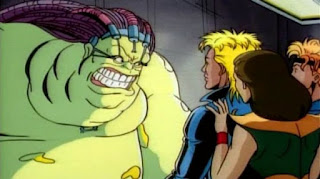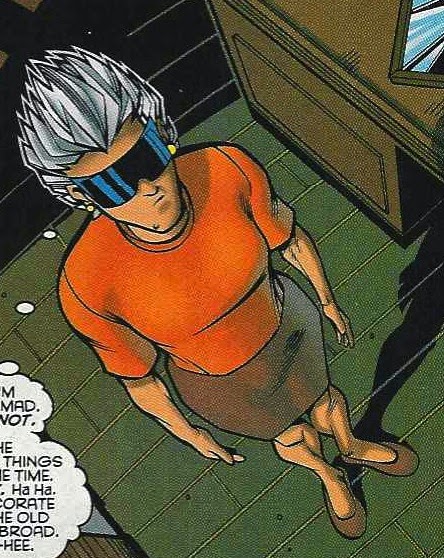Today’s reading: Deadpool #21 and 22, Oct.-Nov. 1998
Story by Joe Kelly
Art by Walter McDaniel and John Livesay (#21) and Anthony
Williams and Andy Lanning (#22)
Back before Marvel decided to chronically renumber all its
titles, every 25th issue was treated as a big deal. There was an
epic battle, or a key character was killed or brought back to life, or at the
very least a holofoil or gatefold cover.
Issue #25 of Deadpool, for a bit, was also supposed to be the series’
last issue, making it doubly important.
But we’re not at issue #25 yet. We’re at issues #21 and 22,
oh-so-close to the final story arc, “Dead Recknoning.” And the producers are
off-camera, telling the talent to stretch to fill time.
Last issue gave us a nice breather and some quality bro-time
between Deadpool and Montgomery, Landau Luckman & Lake’s chief precog. The
next two issues see Wade being groomed to take on a just-introduced alien creature
named Tiamat who is apparently the only thing standing between Earth and a
Mithras-conceived utopia. Wade’s orders: Kill.
So, Zoe Culloden’s spent 20-some issues telling Wade he can
be a hero, a good guy, not a piece of human garbage, and what does he have to
do to save the galaxy? The one thing he’s been trained to do all his life that
he’s been trying to get away from for months now – except for that one time
with Ajax;
he had it coming.
Wade reacts to this news by falling into old habits. He gets
stinking drunk on a park bench while toggling through the options on his image
inducer (Pre-cancer Wade! Barrio gangster! The doctor who tried to have Weasel
committed in issue
#6!). He freaks out when someone teleports into his house and sees him
without his mask on. He socks Zoe in the stomach. He stalks Siryn. He gets in a
fight with Cable (perhaps his oldest habit). Call it “Drowning
Man 2, the Re-Drown-ening.”
By this point, everyone’s a little sick of Wade’s self-pity
schtick. Fortunately, his oldest enemy – who at this point is six years out
from co-headlining a series with Wade – knows a thing or two about fulfilling
destiny … and, um, taking out the trash.
“No one thanks the garbage men, Wilson … It’s part of the
job. But everyone still needs us. Without us, the world drowns,” says the man
whose sole purpose in life prior to 2000 was to kill Apocalypse. “I ain’t dead
yet (at this point, Cable has been poisoned by the techno-organic virus within
him, so he thinks he’s dying), and the trash still needs to be picked up.”
By issue’s end, Deadpool is back at LL&L and ready to drag
the cans to the curb save the day. Just in time for the overbearing
Overboss Dixon to deliver some bad news.
Noah is dead.
You guys remember Noah, right? He’s the other guy who works
at LL&L who has a name. Works with Zoe but takes his orders directly from
Dixon? Well, yeah, he’s dead, killed by Tiamat while scoping out a facility in Puerto
Rico.
Because Dixon sent him there to get killed. Noah apparently
had begun to grow a conscience and a spine, questioning the overboss one time
too many. And Dixon remains so convinced Deadpool will fail his mission that he
will kill and mindwipe his own people to ensure that happens. To make the
matter more of a shame, Dixon had apparently just recommended Noah for
enrollment in the overboss program, which must be the LL&L equivalent of
“He had two weeks till retirement.”
Oh, and guess who’s back? Gerry the bum! Last seen giving an
unconscious Wade a pep talk in issue
#14, everyone’s favorite burned-out hippie who’s more than meets the eye
shows up in issue #21 floating and sipping tea in the Sanctum Santorum of Doctor
Strange, who’s having a hard time coping with the fact that DP, whom he
describes as “a living maelstrom of negative energy,” is being trusted with the
fate of humanity.
“You know as well as I that sometimes destiny just points
his finger and chooses someone … He’s very stubborn that way,” Gerry says as
Strange drops his teacup and saucer in shock.
Finally, let us wrap with another Great Moment in
Pool-o-vation! When Wade returns to LL&L at the end of issue #22, ready to
do what needs to be done to save the Earth, he offers the following words to
Zoe and Monty:
“You wanna scare a Girl Scout, do it yourself. You want to
see a grown man cry like he’s just seen Bea Arthur naked? You leave it to me.”
Ladies and gentleman, I do believe this is canonically the
first in what will be a long line of Deadpool’s patented Bea Arthur references,
although in the future they will betray more of Wade’s fondness for the de
facto leader of the Golden Girls.
Next time on Thursdays with Wade, Deadpool faces his destiny
as “Dead Reckoning” is at hand. See ya then!
In addition to writing
for The Matt Signal, Dan Grote is now the official comics blogger for The Press
of Atlantic City. New posts appear Wednesday mornings at PressofAC.com/Life. His
new novel, Magic Pier, is available however you get your books online. He and Matt have been
friends since the days when Onslaught was just a glimmer in Charles Xavier's
eye. Follow @danielpgrote on Twitter.


















































